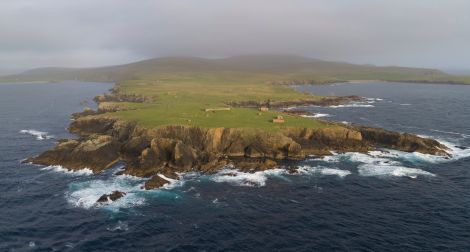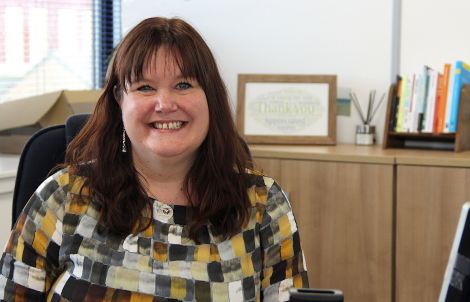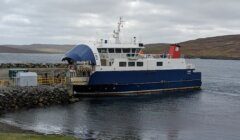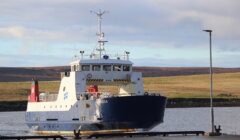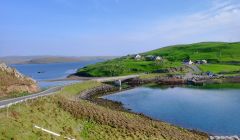Transport / Space centre and energy project plans strengthen case for Yell and Unst fixed links, SIC tells government
The council says it is “essential” there is investment in transport infrastructure to support nationally significant projects such as the space centre
THE IDEA of fixed links connecting Unst and Yell to the Shetland mainland has been promoted by the council to the UK Government – with officials believing plans for a space centre and a clean energy scheme strengthen the case.
Shetland Islands Council (SIC) told the UK Government that plans for the Unst-based satellite launch facility and the ORION clean energy project are of national importance – and that investment in transport infrastructure around these is “essential”.
The support for fixed links connecting Yell and Unst, which are currently served by ferries, to the Shetland mainland by tunnel features in a response to a UK Government consultation on connectivity.
SIC chief executive Maggie Sandison told Shetland News that the “key thing is we’ve never had the money to be able to do it, and we need somebody – whether it’s UK Government or Scottish Government – to take that seriously”.
In recent months fixed links has emerged as a key political topic locally, appearing to gain extra momentum after the long-running issue of inter-island ferry running costs was resolved by the Scottish Government.
Tunnels and bridges are heralded as a way of removing barriers to travel, and opening up new opportunities and investment for islands.
With a drive towards ‘net zero’ in Scotland by 2045, they could also provide an opportunity to replace the council’s carbon-intensive ferries.
Earlier this year first minister Nicola Sturgeon told Shetland News there was a “strong case to be made for fixed links” locally.
Sandison said the SIC took the opportunity to raise future transport connections in Shetland to the UK Government in its recent Union Connectivity Review consultation.
“We’re recognising that Shetland is doing quite a lot of things that have a national interest,” she said, referring to Shetland Space Centre and the ORION project.
Become a member of Shetland News
The consultation response added that “these projects will contribute substantially to the UK’s position in the commercial space industry and energy security for the UK”.
“To ensure the long term viability of these important growth sectors it is essential that the inter-island transport links that support these sectors are improved to ensure access to labour markets within the islands is secure and reliable and that supply and logistics chains to the islands are also reliable and robust,” it said.
Sandison said when it came to the energy proposals, a key link to the North Isles is people living in Yell and Unst working at Sullom Voe Terminal, which could form part of the ORION project – potentially as a home for a new hydrogen plant.
The space centre team previously said its proposed satellite launch facility in Unst – which aims to become UK’s first space port – will eventually create around 140 jobs in Unst, and provide employment for a further 70 throughout Shetland.
The consultation response reiterates that studies have “concluded that linking the main islands in Shetland through a network of fixed links is the way in which we can support growth, support sustainable communities and attract inward investment to Shetland”.
Links connecting Yell, Unst, Whalsay and Bressay have historically been regarded as viable options for tunnels and/or bridges.
The key sticking point is money, but the consultation response says: “It is reasonable that, where transport investment requirements support the development and delivery of nationally important infrastructure, that the UK Government supports the necessary costs.”
Sandison said there is a perception in the community that the council is sitting on plenty of cash, “but we use that money every single year to keep our services going”.
Councillors were told last week that that the value of the SIC’s investment rose by more than £100 million over the 2020/21 financial year to £423 million, but they were warned that things need to be viewed long-term as market conditions can be volatile.
“If we spend a lump sum, basically our services would have to be reduced,” Sandison added. “So it is about finding somebody that would be willing to invest in fixed links for us.”
She also said that it would beneficial for the council to have the risk involved in building fixed links shared with others.
The SIC’s consultation response also said decisions around transport investment traditionally have been “driven by a model which reinforces regional imbalances”.
“Future investment appraisal needs to be more sophisticated and should consider how a project supports local, regional and national outcomes,” it said.
“Taking the case for fixed links between Yell and Unst and Yell and mainland Shetland as examples, these projects underpin the viability of the Unst Space Centre and the Shetland Energy Hub which in turn support the UK’s commercial presence in the Space economy and energy security for the UK.
“Conventionally, transport appraisal has focused on journey time savings for travellers.
“For projects that relate to high travel volumes, projects have ‘scored’ highly in terms of value. This is an outdated concept for a range of reasons.
“Now the focus needs to shift to a broader evaluation of the value of connectivity to support strategic projects where they deliver new opportunities and growth for the UK as well as local benefits.”
In the meantime, Sandison said as fixed links are a long-term vision managing the council’s existing ferry fleet remains a priority.
But she said the SIC’s recently approved Our Ambition blueprint for the future is “quite clear that the council continues to support longer term solutions rather than just ferries”.
Sandison, meanwhile, brought up the idea of connecting Unst and Yell to the mainland by fixed link to a UK Government officer in relation to the SIC’s motion last year to explore options for self-determination.
In an email seen through a freedom of information request, Sandison highlighted Shetland Space Centre, the Dales Voe decommissioning facility and the energy hub plans as ways Shetland could contribute further to the UK and Scottish economies in the future.
In the email sent in February she also raised the issue of a “Shetland tariff”.
This revolves around the idea of providing cheaper electrical prices to islanders – potentially alleviating fuel poverty in the process – because Shetland will become a net exporter of renewable power once the Viking Energy wind farm comes on stream in 2024.
Sandison said the council believes the isles’ renewable energy sources will provide the net zero solution for oil and gas production west of Shetland through electrification.
“The oil and gas sector will access electric from wind at a tariff which is unavailable to householders and island businesses (or the net zero transition won’t happen) and we believe this is an opportunity for Shetland to access the same tariff – the solution maybe a Special Economic Zone or a new Zetland County Council Act which enabled the development of oil industry in the 70s,” the chief executive wrote.
In the email Sandison also said a next step in exploring the self-determination motion would be through a series of workshops on themes where the council believes Shetland could have greater management or control.
Areas the chief executive said she would be keen to explore would include transport and digital connectivity, Crown Estate and fisheries management, and energy.
Become a member of Shetland News
Shetland News is asking its readers to consider paying for membership to get additional perks:
- Removal of third-party ads;
- Bookmark posts to read later;
- Exclusive curated weekly newsletter;
- Hide membership messages;
- Comments open for discussion.
If you appreciate what we do and feel strongly about impartial local journalism, then please become a member of Shetland News by either making a single payment, or setting up a monthly, quarterly or yearly subscription.






